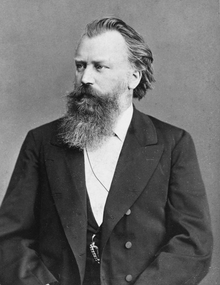Cello Sonata No. 2 (Brahms)
| Cello Sonata in F major | |
|---|---|
| No. 2 | |
| by Johannes Brahms | |
 The composer c. 1885 | |
| Native name | Sonate für Klavier und Violoncello |
| Key | F major |
| Opus | 99 |
| Composed | 1886 |
| Dedication | Robert Hausmann |
| Published | 1887 |
| Movements | four |
The Cello Sonata No. 2 in F major, Op. 99, was written by Johannes Brahms in 1886,[1] more than twenty years after completing his Sonata No. 1. It was first published in 1887.[2] It was written for, dedicated to and first performed by Robert Hausmann, who had popularised the First Sonata, and who would the following year be given the honour of premiering the Double Concerto in A minor with Joseph Joachim.
Musical description
[edit]There are four movements:
First movement
[edit]The Allegro vivace is a sonata form opening with a fragmented cello theme over a tremolo piano part.[3] Its bipartite exposition somewhat unusually traverses F major, C major, and A minor;[4] Roger Graybill argued that the tonal plan may be read as ultimately returning to F major, given the intricate motivic structure of its voice leading.[5]
Second movement
[edit]Adagio affettuoso, with the cello part opening in a pizzicato exposition of the main theme over piano chords.[6] The central section is in F minor.[7]
Third movement
[edit]Allegro passionato in F minor, with a more songlike trio section in F major.
Fourth movement
[edit]Allegro molto; a rondo.
Notes
[edit]- ^ "About - Johannes Brahms - Cello Sonata No.2 in F, Op.99". All Music Guide. 2008. Retrieved 2013-02-26.
- ^ a b c IMSLP2 score.
- ^ Woodstra, Chris; Brennan, Gerald; Schrott, Allen (2005). All music guide to classical music: the definitive guide to classical music at Google Books, page 191. Hal Leonard Corporation. ISBN 0-87930-865-6.
- ^ Graybill 1988, 43.
- ^ Graybill 1988, 49–51.
- ^ Page 13 of 32 of IMSLP2 first score - first two bars of Adagio affettuoso.
- ^ All music guide; IMSLP2 score.
Bibliography
[edit]- Graybill, Roger. 1988. "Harmonic Circularity in Brahms's F Major Cello Sonata: An Alternative to Schenker's Reading in Free Composition". Music Theory Spectrum 10(1):43–55. doi:10.1525/mts.1988.10.1.02a00040.
External links
[edit]- Brahms Cello Sonata No. 2: Scores at the International Music Score Library Project
- Performance of Cello Sonata No. 2 by Wendy Warner (cello) and Irina Nuzova (piano) from the Isabella Stewart Gardner Museum in MP3 format
